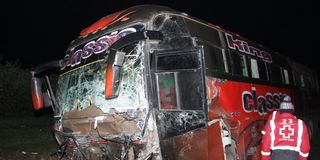
Rescuers at the scene of the road crash at Twin Bridge area of Mau Summit along the Nakuru-Eldoret highway that claimed the lives of 15 people on January 09, 2023.
The section of the busy Nairobi-Nakuru-Eldoret highway, set to undergo a Sh160 billion upgrade, has transformed into a perilous route claiming numerous lives, prompting calls for urgent government intervention to expand and enhance the key road.
Here, death is just a slip away as the mere mention of some blackspots invokes fear among motorists and travelers familiar with the treacherous stretches.
The important route links the capital Nairobi to Western Kenya and is a crucial connection to landlocked countries such as Uganda, Southern Sudan, Rwanda, and Burundi.
Unfortunately, it has evolved into a paved graveyard, witnessing tragic accidents that result in the loss of lives, leaving countless others nursing injuries.
Numerous scars from past accidents mar the road, evident in broken glasses, mangled vehicle parts, worn-out tyres by the roadside and haunting echoes of the dying, maimed, widowed and orphaned.
Stakeholders in the transport industry attribute most accidents to recklessness, speeding, overloading, and the use of roadworthy cars.
The escalating number of accidents has frequently sparked public outcry, with citizens expressing concerns about the safety of motorists using the highway.
Now pressure is mounting on the government to expedite the planned upgrade of the road into a six-lane dual carriageway through a Public-Private Partnership (PPP) model.
Both the National Transport and Safety Authority (NTSA) and the traffic police department are under scrutiny as the public demands accountability for the rise in road accidents along the busy road.
Engineers and industry players cite design flaws, vandalism of road signs, and reckless driving as key contributors to the road's notoriety as a death trap.
But what exactly is behind the rising accidents along the busy road?
According to Mr David Ngugi, an engineer, design flaws and vandalism of road signs have contributed to making the road 'a certified death trap'.
"Reckless driving, dangerous overtaking, lane indiscipline are to blame for frequent accidents along the route. Vandalised road signs make it difficult for motorists to observe traffic rules," says Eng Ngugi.
Read: 'Straight out of horror movie': The ill-fated matatu that killed everyone on board in Mau Summit
“The much-awaited upgrade of the key road is long overdue. Once the road is upgraded into about six lanes, accidents will significantly be reduced. Lane discipline will reduce the accidents we are witnessing currently.”
Motorists and industry stakeholders have called on the government to swiftly commence the much-anticipated highway upgrade.
Mr John Langat, a first responder to accidents along the Ngata-Sobea-Salgaa stretch, said the planned upgrade of the Rironi-Mau Summit highway will markedly reduce accidents along the Northern corridor.
Mr David Kuria, a motorist who owns a fleet of matatus plying the Nakuru-Western Kenya route, agrees that the main cause of frequent accidents along the highway is careless driving.
“We urge the government to swiftly commence the much-awaited highway upgrade. Most of the accidents that have claimed lives along the highway happen because of lack of lane discipline among motorists,” he said.
In the past two months alone, at least 40 people have lost their lives in separate road crashes along the highway.
The tragic incidents have fueled the urgency for comprehensive road improvements to address the underlying causes of accidents.
The most recent accident at the Twin Bridge area in Mau Summit claimed 15 lives when a 14-seater Northways Shuttle collided head-on with a Classic Kings of Congo bus.
Witnesses revealed that the Northways Shuttle driver was speeding and engaging in dangerous overtaking before the fatal collision.
Transport Cabinet Secretary Kipchumba Murkomen acknowledged the government's commitment to upgrading the highway.
He revealed that plans for the upgrade were temporarily halted due to the high cost associated with the existing contract.
The government is exploring alternative approaches to avoid imposing a heavy toll on Kenyans and ensure equitable access to the improved road.
“We had a grand dream to upgrade the Nairobi-Mau Summit highway and have it dualled. However, the existing contract that was meant to have the work done was found to be very expensive and would put an unnecessary loan burden on Kenyans, “ Mr Murkomen said in an interview.
“It also makes it impossible for every Kenyan to use the road, because unless you have money to pay a toll station the road will not be done. So my ministry is thinking of how we can construct the road without punishing Kenyans in terms of payment of the toll fees and telling them to pay a debt of about Sh300 billion to only build 175km,” the Cabinet Secretary explained.
The Nation independently established that another reason why President William Ruto's administration put brakes on the project, was the absence of an alternative route for motorists, who do not want to pay toll fees, as is the case with the Nairobi Expressway.
“The Kenya Kwanza administration put off the project to rethink the best way to acquire an alternative route for users who did want to pay for the road,” said a source, privy to the construction of the project, who did not want to be named as he is not allowed to speak to the media.
The Nation has also learnt that if the original contract was not put on hold, it could make motorists pay between Sh1,050 and Sh6,300 to drive on the multi-billion dual carriageways.
For every kilometre on the highway, a motorist would part with Sh6 on any section of the road. This translates to Sh1,050 for saloon cars and Sh6,300 for big trucks.
According to the cancelled contract, once complete digital toll stations were to be built along the 175km stretch between Rironi and Mau Summit, and motorists charged depending on the size of the vehicle.
In the Salgaa section, a series of accidents along the stretch prompted the government to initiate the construction of a concrete barrier, which finally tamed the road carnage along the stretch.
The concrete barrier erected by the government in 2019, separating lanes of traffic, has seen a drastic decline in motor accidents along that Salgaa-Sachangwan stretch. China Railway Number 10 Engineering Group constructed the barrier.







